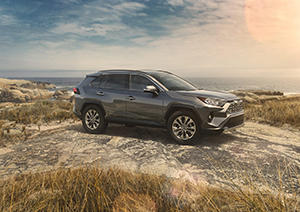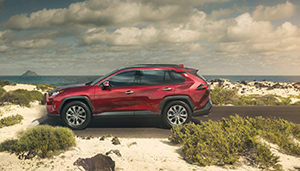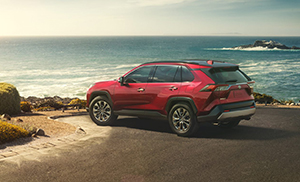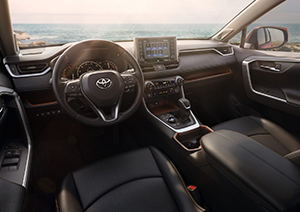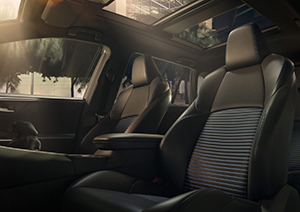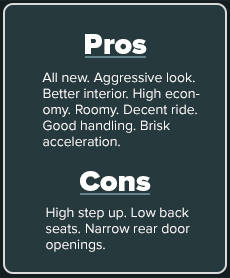2019 Toyota RAV4 AWD Hybrid
Limited
The 2019 Toyota RAV4 Hybrid continues pioneering ways
Price: $35,700
Toyota, itself, probably didn’t realized the big market it was opening
up with its first RAV4 compact SUV/crossover, introduced for 1997.
Many generally felt it would make only a small market dent, but now a
good chunk of the vehicle buying public wants a compact SUV/crossover.
(Let’s just call the RAV4 a compact SUV.)
The four-door hatchback RAV4 long has been a hot seller, and the
all-new 2019 version is much improved, especially in the gas/electric
hybrid form I tested. The RAV4 comes with either front- or all-wheel
drive (AWD) in regular or hybrid form and promises to continue its
winning ways.
Prices start at $25,500 for the front-drive gas-only version and zip go
to $35,700 for the top-line Limited hybrid AWD version I tested.
This fifth-generation RAV4 looks more aggressive than its predecessor.
It has a 1.2-inch longer wheelbase for more rear legroom and is 180.2
inches long. Front and rear tracks are wider for a brawnier stance and
front and rear overhangs are shorter. Chromed dual exhaust outlets and
18-inch Super Chrome Finish” alloy wheels add to the RAV4’s sporty look.
The power hatch glides open to reveal an enlarged cargo area, and split
rear rear seat backs easily flip forward and sit flat to create an
extra-large area.
The RAV4 is 67 inches high, which calls for extra effort to get in and
out to the improved interior. The cabin has supportive front seats and
an especially upscale look with a revised dashboard and soft-touch
surfaces. There’s a power driver’s seat in the Limited, but the front
passenger seat is manually operated. No excuse for this in a top-line
model, although front seats are heated.
Despite a lower belt line for more occupant visibility, rear seats are
set lower than the front ones. That may dismay shorter rear occupants
who may feel a bit submerged.
Dismaying me was the camera-assisted rearview mirror, which caused me
to feel distracted because it showed more than the normal number of
lanes and vehicles behind me. Call it “visual pollution. However, that
mirror can easily be flipped to a normal position, and there are fairly
large color-keyed and heated power outside mirrors.
Front doors open wide, but rear door openings are narrow, making it
harder to enter or leave this high vehicle. And the stiff rear-seat
center is best left to short drives. Leave that area to the wide
fold-down rear armrest, which contains hefty cupholders. The cabin has
nicely sized front cupholders and a bunch of storage areas, including a
handy in-dash tray with slide-out protection for such small items as
mobile phones.
A power tilt/slide sunroof lets more of the outside world in and
upscale cabin features include a dual-zone automatic air conditioning
system with rear vents, which was appreciated during an especially hot
Chicago summer, a pushbutton start and a premium audio system with an
8-inch touchscreen. There’s also a 7-inch color multi-information
display and charge ports
The powertrain of the RAV4 AWD Hybrid consists of a sophisticated
2.5-liter four-cylinder engine and two electric motors.
Combined net gas-electric horsepower is 219. Only 87-octane fuel is
required.
There’s a rear driveline disconnect system when AWD isn’t needed when,
say, on long highway stretches for better fuel economy.
The Hybrid has quick acceleration and good freeway performance, helped
by an electronic continuously variable (automatic) transmission. Drive
modes can be easily set to Normal, Economy, Trail and Sport. A
manual-shifting feature works quickly.
Estimated fuel economy is good for a fairly large, 3,490 pound compact
SUV hybrid. It’s an estimated 41 miles per gallon in the city and 38 on
the highway.
The quick steering is on the firm side, as is the ride. But the new
RAV4 has a smoother, quieter ride than its predecessor, although sharp
bumps can be felt. Handling is good, helped by the clever “Dynamic
Torque Vectoring” AWD system. The brake pedal has a linear acton, and
brakes have electronic brake-force distribution.
My nicely assembled RAV4 felt especially strong, partly because it has
a 57 percent more rigid structure than its predecessor. The interior is
quieter, and the engine doesn’t make much noise under heavy
acceleration.
A bunch of option packages raised my test vehicle’s list price to
$40,833. They included everything from a heated steering wheel,
elaborate sound system, foot-operated power hatch and a nifty Bird’s
Eye View camera with a perimeter scan that allowed an overhead
360-degree view in drive and reverse gears, besides a curb view.
Safety items show the latest RAV4 is world’s apart from the first one.
For instance, my test RAV4 had a pre-collision system with pedestrian
detection, full-speed range dynamic radar cruise control, lane
departure alert with steering assist, lane tracing assist, vehicle and
traction control systems, eight air bags, blind spot monitor,
integrated back-up camera and smart stop technology.
Lift the heavy hood and you’ll see that the complicated-looking engine
compartment is best left to Toyota technicians.

